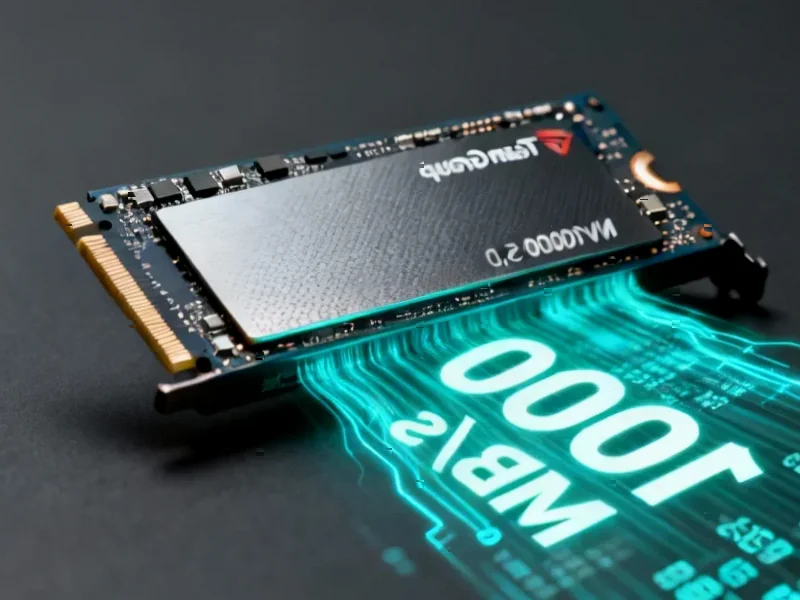According to Guru3D.com, Kingston Technology has expanded its FURY Renegade G5 SSD lineup with an 8TB model that achieves sequential read speeds up to 14,800 MB/s and write speeds up to 14,000 MB/s. The PCIe 5.0 NVMe M.2 drive leverages a Gen 5 x4 controller with 3D TLC NAND memory and exceeds 2 million IOPS in random operations, making it one of the fastest consumer-grade SSDs available. Keith Schimmenti, Kingston’s SSD business manager, emphasized that the expansion addresses growing demand from users handling large files like uncompressed media and modern games exceeding 200GB per title. The complete lineup now spans from 1TB to 8TB capacities, all backed by a five-year warranty and optimized firmware for sustained performance.
The Thermal Elephant in the Room
While Kingston’s performance numbers look impressive on paper, PCIe 5.0 SSDs face significant thermal challenges that marketing materials often downplay. The combination of high-speed controllers and dense 3D TLC NAND in an 8TB package generates substantial heat that can trigger thermal throttling during sustained workloads. Many early PCIe 5.0 adopters have discovered that without active cooling solutions, these drives rarely maintain their advertised speeds for more than brief bursts. For professionals working with large video files or extended rendering sessions, this thermal reality could mean the difference between promised 14,000 MB/s performance and significantly reduced transfer rates.
The Reliability Question at 8TB Scale
High-capacity SSDs introduce unique reliability considerations that aren’t present in smaller drives. With 8TB of 3D TLC NAND, wear leveling becomes exponentially more complex, and the drive controller must manage significantly more potential failure points across the NAND array. While Kingston’s reputation for reliability is well-established, pushing consumer-grade technology to these extremes raises questions about long-term endurance that the five-year warranty may not fully address. Professional users storing critical project files need to consider whether consumer-grade 8TB solutions offer the same data integrity guarantees as enterprise alternatives with more robust error correction and power-loss protection.
Is the Market Ready for 8TB Gen 5?
Kingston’s timing with this release raises questions about the actual market readiness for such high-capacity PCIe 5.0 storage. Most consumer motherboards with PCIe 5.0 M.2 slots are still relatively rare and command premium prices, while the performance benefits over high-end PCIe 4.0 drives remain marginal for most real-world applications. The professional creators and gamers Kingston targets may find that investing in multiple PCIe 4.0 drives in RAID configurations offers better value and similar performance without the thermal complications. As industry testing has shown, the practical difference between Gen 4 and Gen 5 speeds often disappears outside synthetic benchmarks.
The Unspoken Cost Premium
Perhaps the most significant unaddressed factor is pricing. Previous FURY Renegade models already commanded premium prices, and scaling to 8TB with PCIe 5.0 technology suggests a price point that could approach or exceed $1,000. At that level, buyers must question whether the performance justifies the cost compared to established enterprise solutions or multiple smaller drives. The economics become even more questionable when considering that most users won’t fully utilize either the capacity or the speed simultaneously, making this potentially an expensive solution looking for problems that don’t exist for most of its target market.
What This Means for Storage Evolution
Despite these concerns, Kingston’s move signals an important industry trend toward higher capacity consumer storage. As game install sizes continue ballooning and 8K video editing becomes more common, the demand for large, fast storage will only grow. However, the real innovation needed isn’t just bigger numbers—it’s better thermal management and more efficient controllers that can deliver sustained performance without elaborate cooling solutions. Until the industry solves these fundamental engineering challenges, high-capacity PCIe 5.0 drives may remain impressive on spec sheets but disappointing in practical application for all but the most specialized use cases.




